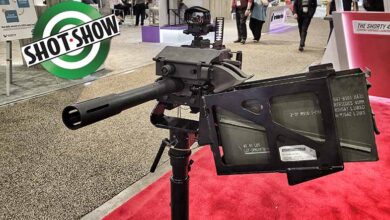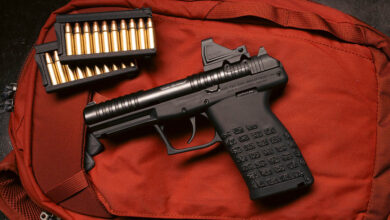TruGlo Triton: A Reliable $100 Optic?
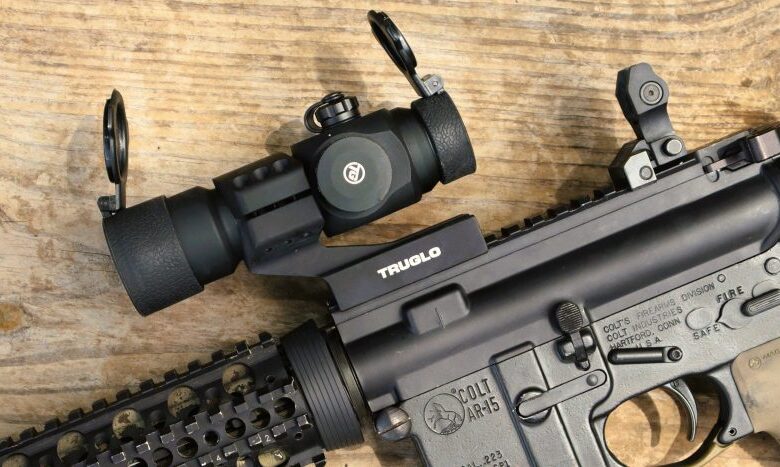
I rarely shy away from an opportunity to review a product. For me, the goal isn’t to label a product as “good” or “bad”; rather, reviews should help us determine the best task and purpose for a product. When I decided to review the TruGlo Triton tri-color dot sight, I wondered just how useful and reliable this optic could really be. At just over $100, I heard the mantra from an early mentor, a USMC Korean War veteran named Jerry, echoing in my thoughts. Jerry often quipped, “There are good scopes, and there are cheap scopes, but there are no good, cheap scopes.” Unfortunately, Jerry passed away right around the time competition and technology started to flourish throughout the optics market. Price points once believed to be “cheap” became synonymous with durability and reliability.
The TruGlo Triton, which currently sells for $119.90 on GMW, seems to have a lot of features and options for less than $150. That price may be a good deal, but is it too good to be true? What gun is the TruGlo Triton good for? How much abuse can it withstand? Prejudices aside, let’s see where the TruGlo Triton fits — good, cheap, or both.
TruGlo Triton Tri-Color Dot Sight
While its name isn’t much, for brevity’s sake, the TruGlo Triton Tri-Color Dot Sight looks like any other traditional red dot optic. The Triton is a 30mm unmagnified tube with a single 5 MOA dot electronic reticle. The reticle features three color choices (red, blue, and green) with four brightness settings (off, 1, 2, and 3) for each color.
The TruGlo Triton includes a cantilever mount compatible with Picatinny and Weaver-style bases. The mount secures with two Allen screws, and the mounting height is about perfect for a lower-third co-witness with most AR sights. Mounting was quick and easy out of the box. I appreciated TruGlo including a tag on the Allen screws to not torque them past 20-ft-lbs with the supplied Allen wrench. I imagine they’ve had a few customers over-torque a base a time or two.
While three different reticle colors are an intriguing feature, the three brightness intensities per reticle leave little room for fine-tuning unfortunately. No one should expect this optic to be night vision compatible. However, a little more adjustment range would go a long way. On several occasions, the reticle washed out from backlighting, and on one occasion, my sunglasses made the reticle almost impossible to see. Ultimately, you can only fit so many settings into a knob, and with four settings and three colors, the adjustment range fills up pretty quickly.
I can talk about the TruGlo Triton’s features and specs all day long, but anyone can find that with a quick Google search. Let’s get into the testing — and abuse — of this little red dot optic.
In the Field and on the Range with the TruGlo Triton
When I started planning what to do with the TruGlo Triton, I decided to focus on practical testing. Okay, maybe some of the testing ventured into the extreme. Nonetheless, the core tests focused on the durability, practicality, and functionality of the TruGlo Triton. How does the Triton hold up to recoil? Can the Triton withstand moisture exposure? The testing ultimately answered these questions and then some.
Sighting-in the TruGlo Triton
It’s hard to review an optic without using it. Once mounted up, it was time for sight-in. As mentioned earlier, the optic settings don’t provide the greatest range of adjustment, and the dot didn’t quite have the precision adjustment I’m accustomed to. Speaking of the dot, I noticed some distortion in the dot’s window that caused additional reflection from the optic’s diode. While not awful, the additional reflection distracted the eye during precision shots.
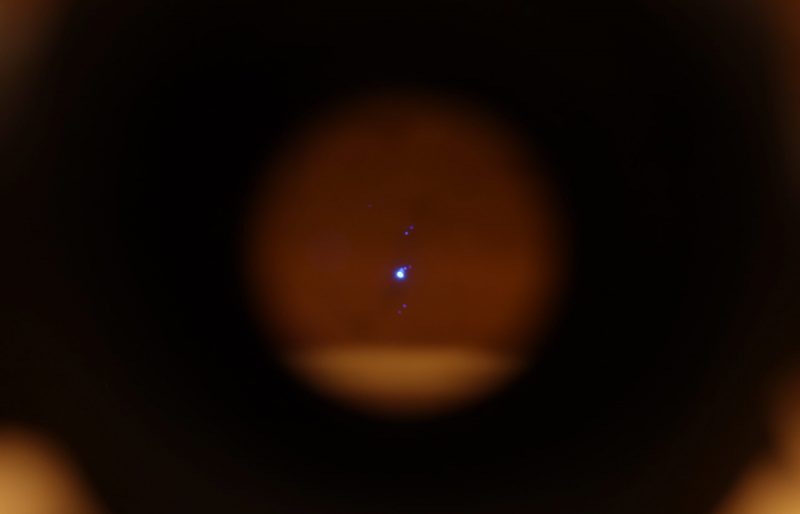
Sight-in went relatively smooth at 25 yards. The dot started seven inches low and around two inches left. After 44 clicks up and 10 right, shots remained consistently in the black. The TruGlo Triton’s instruction manual advertises one MOA adjustment with each click. However, the click adjustments measured closer to 0.75 MOA.
Shooting — a lot
I have a lot of irons in the fire at any given time and try to make efficient use of my time. Coincidentally, I was in the middle of testing Slip2000’s EWL30 weapon lubricant with a 300-round test of EWL30 against another lubricant. With 600 rounds on the menu, it seemed a good time to take the TruGlo Triton for a spin on a full-auto M16. After all, 600 rounds of sustained automatic weapons fire are bound to put an optic through a little trauma.

Surprisingly, the TruGlo Triton remained zeroed after the 600-round test. The .223 Remington cartridge isn’t known for producing significant recoil. However, the constant vibration from 60,000 PSI explosions on a 10.5-inch suppressed rifle will certainly test stability.
After the first 300 rounds, the rear rubber sight cover became the first casualty, as the cross pin ejected and disappeared into the abyss of range gravel and spent brass. Despite that minor inconvenience, the optic retained zero. During later testing, I discovered TruGlo’s cantilever scope ring had worked loose and wasn’t as tight as it should have been. On my part, I should have checked it before and during shooting. Regardless, the optic surprisingly retained zero at 25 yards.
TruGlo Triton Drop Test
Not all optics are made the same. When paying for a higher-end optic, you’re getting more than just features or clearer glass. The biggest feature with higher-priced optics is often unseen: durability. For over a decade, I’ve held the Aimpoint T1 near and dear to my heart. It’s been dropped and banged around on the range, in a patrol car, and during professional use. On one occasion, it rested on the trunk of a car during a range trip and took a brief ride on the deck lid before the optic landed directly on the range gravel. The Aimpoint retained zero and escaped further trauma with only some minor scratches. With the TruGlo Triton, durability was definitely a concern. Will the Triton hold up to such abuse?
Drop testing the Triton wasn’t extravagant. With the optic mounted on a lightweight, budget-built AR-15, I dropped the rifle three times from waist height (around 42 inches) with the optic falling directly on concrete. The first hit put a dent in the objective lens, while the second didn’t seem to do much. The third drop, however, took a toll on the Triton.
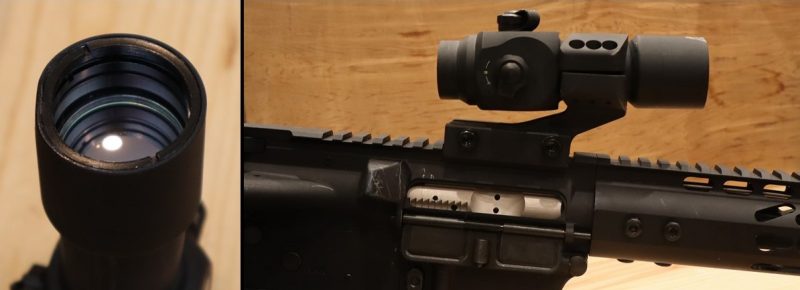
After picking up the rifle from the third drop, I noticed the optic was a bit…off. The optic’s body collapsed forward of the windage and elevation adjustments. The scope ring was noticeably loose — either a byproduct of the 600-round torture test or the scope’s newfound geometry — and the optic now featured a noticeable cant. Undeniably, this was less than ideal, and I ceased further shooting with the optic. However, more testing remained ahead.
The Water Test
Despite recent dirt work, my range still likes to turn into a small pond for critters during the wetter months. After several inches of rain, the murky water seemed to be an appropriate testing site for the TruGlo Triton. As a matter of note, no tadpoles were harmed during this testing.

The test started simply by tossing the optic into the water long enough to submerge it for a few minutes. After that, it went back into a shallow section, and my shoe provided some encouragement with submersing the optic. Overall, the Triton spent around five minutes in or underwater. When I removed the optic, the sight picture changed somewhat.
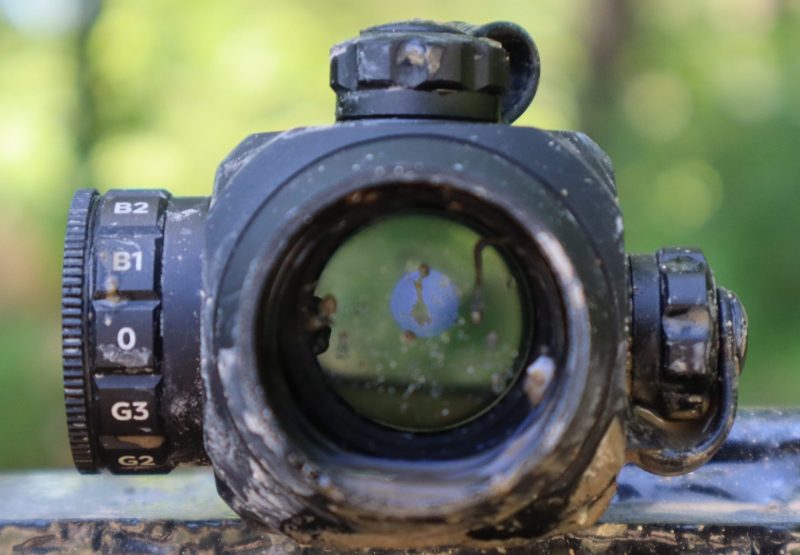
The TruGlo Triton’s diode remained functional with little to no change in clarity or functionality. However, the tube now retained an impromptu level indicator, with murky water obscuring the bottom third of the Triton’s optic window. While not ideal, the fact that the optic’s electronics remained functional was both shocking and surprising. At this juncture, it seemed a good time to retire this economy red dot from further testing.
Is the TruGlo Triton worth the money?
I’ve long said there’s no such thing as “good” or “bad” optics. Rather, an optic should be judged by its purpose and scope of application. While a $2,000 scope will provide incredible service for any end user, not all setups require such an expenditure. Would I put the TruGlo Triton on a home defense or patrol rifle? No. However, the Triton would certainly be at home on a budget range build in need of an optic or a .22 trainer setup.
The TruGlo Triton provides a convenient and economical setup for those looking to get an optic on their rifle, with little expense and few features. For $120, don’t expect this optic to hold up to heavy abuse from banging it around, inclement weather, or other adverse conditions. However, the Triton held up surprisingly well to extended periods of sustained recoil and never lost its zero. For a range, recreational, or even hunting optic, I have full confidence my shots would land wherever I put the dot. That’s definitely a win for the money. Just don’t do what I did to it.
The TruGlo Triton is available from GunMag Warehouse. The standard low Picatinny mount costs $74.99, and the cantilever AR height mount costs $119.90.
The post TruGlo Triton: A Reliable $100 Optic? appeared first on The Mag Life.
Read the full article here

